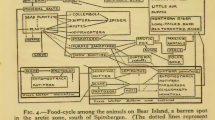Summary and conclusions
Darwin's theory of evolution brought to an end the static view of nature. It was no longer possible to think of species as immortal, with secure places in nature. Fluctuation of population could no longer be thought of as occurring within definite limits which had been set at the time of creation. Nor was it any longer possible to generalize from the differential reproductive potentials, or from a few cases of mutualism between species, that everything in nature was “fitted to produce general ends, and reciprocal uses.” 134 The appeal to “design” could no longer be substituted for answers to questions concerning animal demography. Instead, the dynamics of a population had to be viewed as the outcome of species' struggle against animate and inanimate factors in the environment. Both the members of a species and the environmental factors tend to vary randomly, and therefore neither evolution nor population dynamics could be fully understood alone. For this reason Darwin's linking of the two subjects was inevitable and not merely an historical accident. Since Darwin had shown that no automatic equilibrium existed, he demonstrated the importance of closer study of the causes of population dynamics and extinction. He also indicated that an understanding of population depends upon the development of a broad knowledge in ecology.
Viewed from another direction, Darwin's work ended the early modern era of population studies by clarifying three interrelated problems which were important for understanding population: extinction, distribution, and the nature of species. The components of his answer had been discussed in the eighteenth century, but there had not existed enough evidence for the completion of the revolution in thought which had then begun. At the beginning of the nineteenth century, Playfair found the evidence for extinction conclusive, and, in spite of Lamarck, Curvier convinced the scientific world that there could no longer be any doubt about it. This was a step the importance of which, with his limited knowledge of biogeography and population, Cuvier could not have fully realized. Lamarck attempted, with his evolutionary theory, to circumvent the necessity for admitting extinction, but he overestimated the adaptability of organisms and in doing so he underestimated the importance of competition and the whole field of ecology. On the other hand, he was not willing to let questions such as the origin of species remain taboo to science. The origin of species was a biogeographical as well as a paleontological question. Humboldt correlated environment with the distribution of species and conveyed the impression that plant communities are subject to change. De Candolle, following the lead of Linnaeus and Humboldt, emphasized the ecological aspects of biogeography, not only the importance of habitat and range, clearly showing the ecological effects of competition. The entomologists Kirby and Spence took a faltering step toward understanding the relationship between population and ecological role, but they fell short of any significant new conclusions. Neither they nor Swainson could fully comprehend the new perspective of De Candolle.
Lyell was able to bring together the evidence from these three lines of investigation and weave them into an important synthesis that almost accomplished that Darwin later did. Although opposing Lamarck's theory of evolution, Lyell had a dynamic view of ecology. He realized that population dynamics offered an important key to the understanding of biogeography. Since he knew that species become extinct, he investigated closely the factors which could either preserve or extinguish species. While explaining these factors, he described the interrelationships of species in greater detail than had ever been done before. Forbes continued to develop Lyell's ecological concepts, and his first-hand field experience enabled him to describe biotic communities more concretely than Lyell had.
Having the advantages of Lyell's understanding and his own experience from a global voyage, Darwin could take the final step from the static to the dynamic concept of life. He had seen populations fluctuating and also fossil species in South America, and on the Galapagos Islands he had encountered a biogeographical problem that could not be credibly solved without the idea of evolution. However, the bare idea of evolution did not fully answer his questions. He sought physiological causes of extinction before he read Malthus and realized that De Candolle and Lyell had correctly emphasized the importance of competition. Darwin found that, in order to understand evolution, he needed to improve his understanding of ecology. He wanted to know when populations were most easily decimated, how extensive were competition and cooperation, what effects parasites have upon populations, and what changes occur in biotic communities when a species is either added or subtracted. He contributed to some extent to answering these questions. Though there remained much for others to do, there was now a new and more secure theoretical framework within which later studies could be interpreted. As Ernst Mayr has observed, Darwin's “consistent thinking in terms of population has had an impact on biological theory and practice which is second only to his sponsorship of natural selection as the mechanism of evolution.” 135
Similar content being viewed by others
Author information
Authors and Affiliations
Rights and permissions
About this article
Cite this article
Egerton, F.N. Studies of animal populations from Lamarck to Darwin. Journal of the History of Biology 1, 225–259 (1968). https://doi.org/10.1007/BF00351922
Issue Date:
DOI: https://doi.org/10.1007/BF00351922




